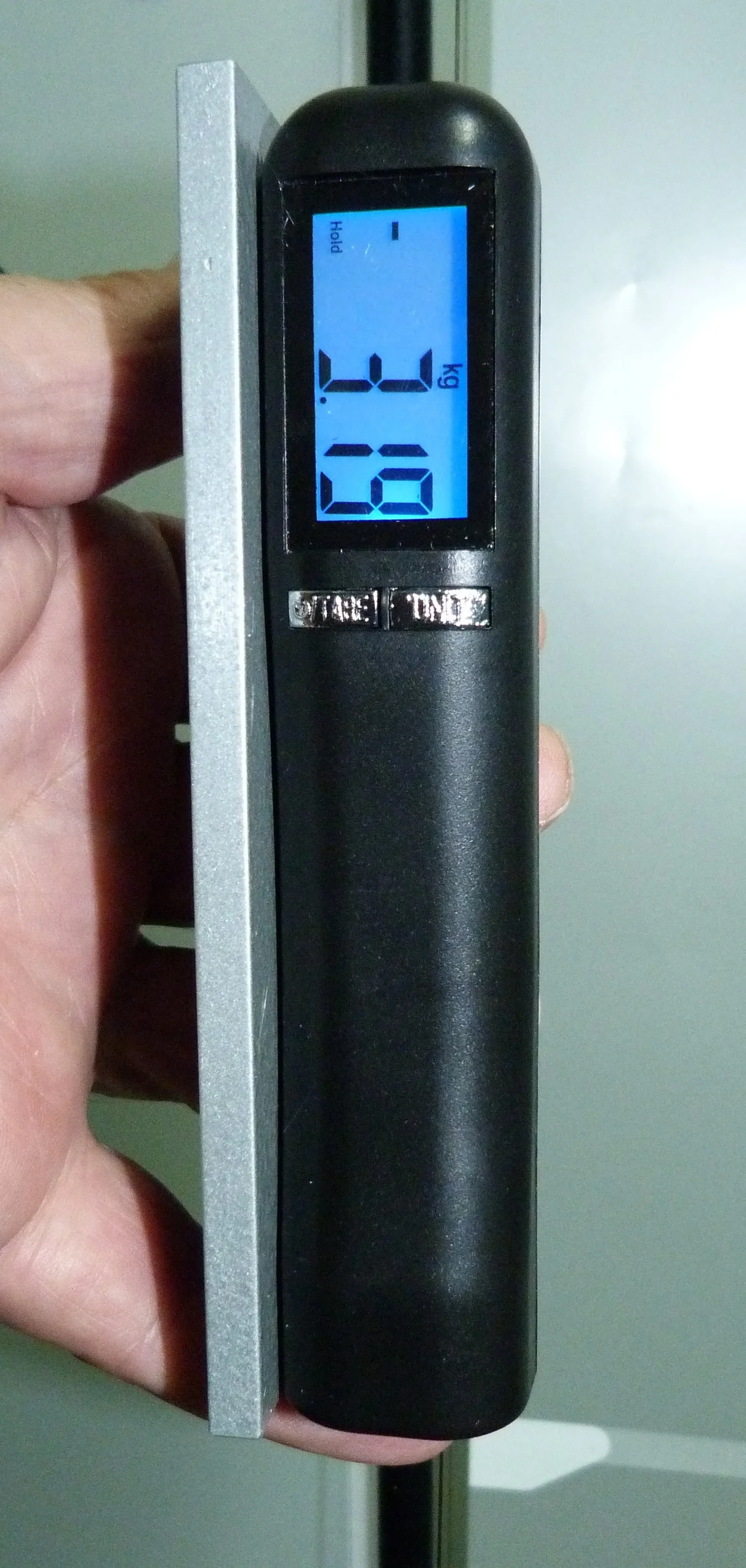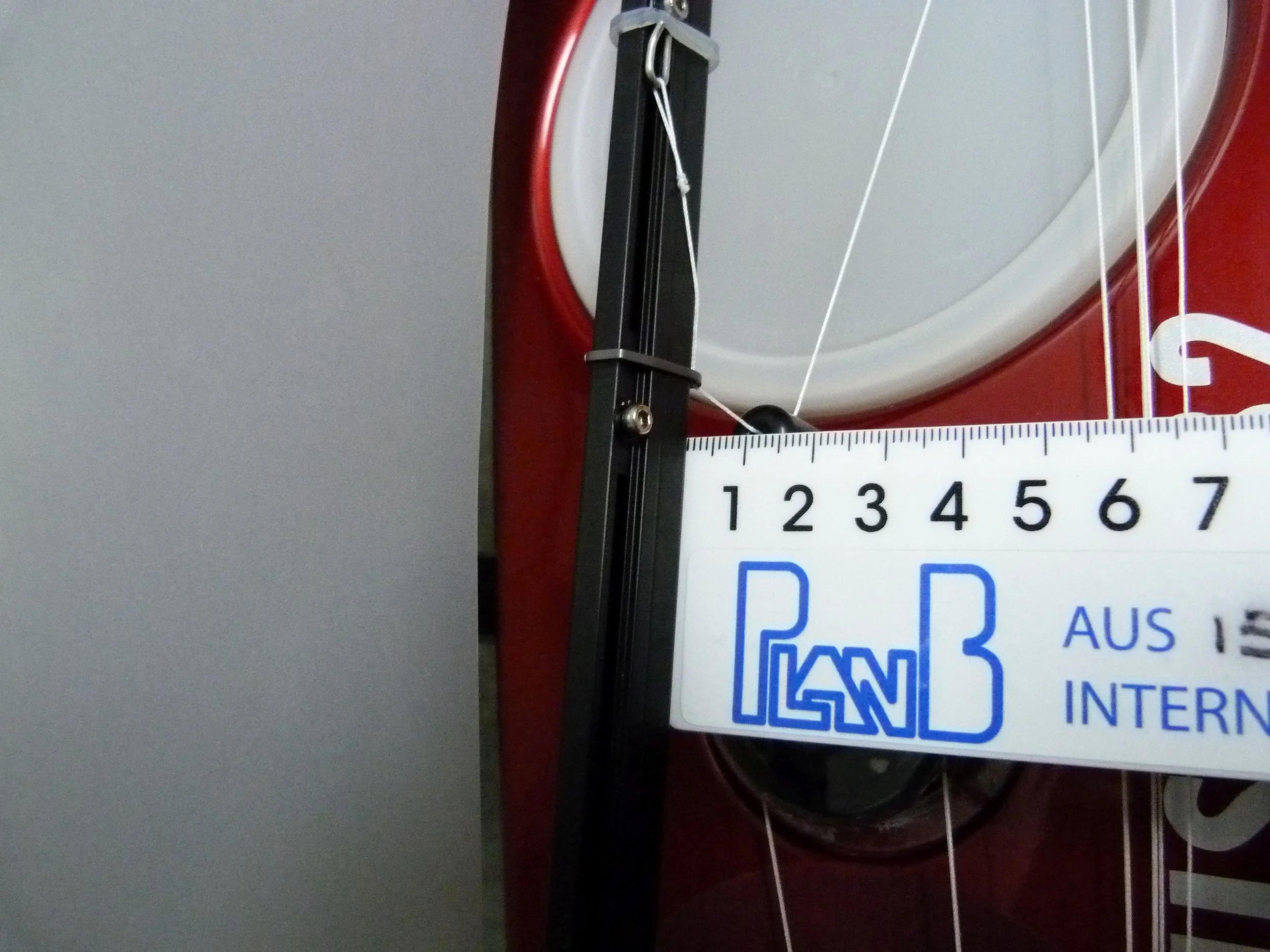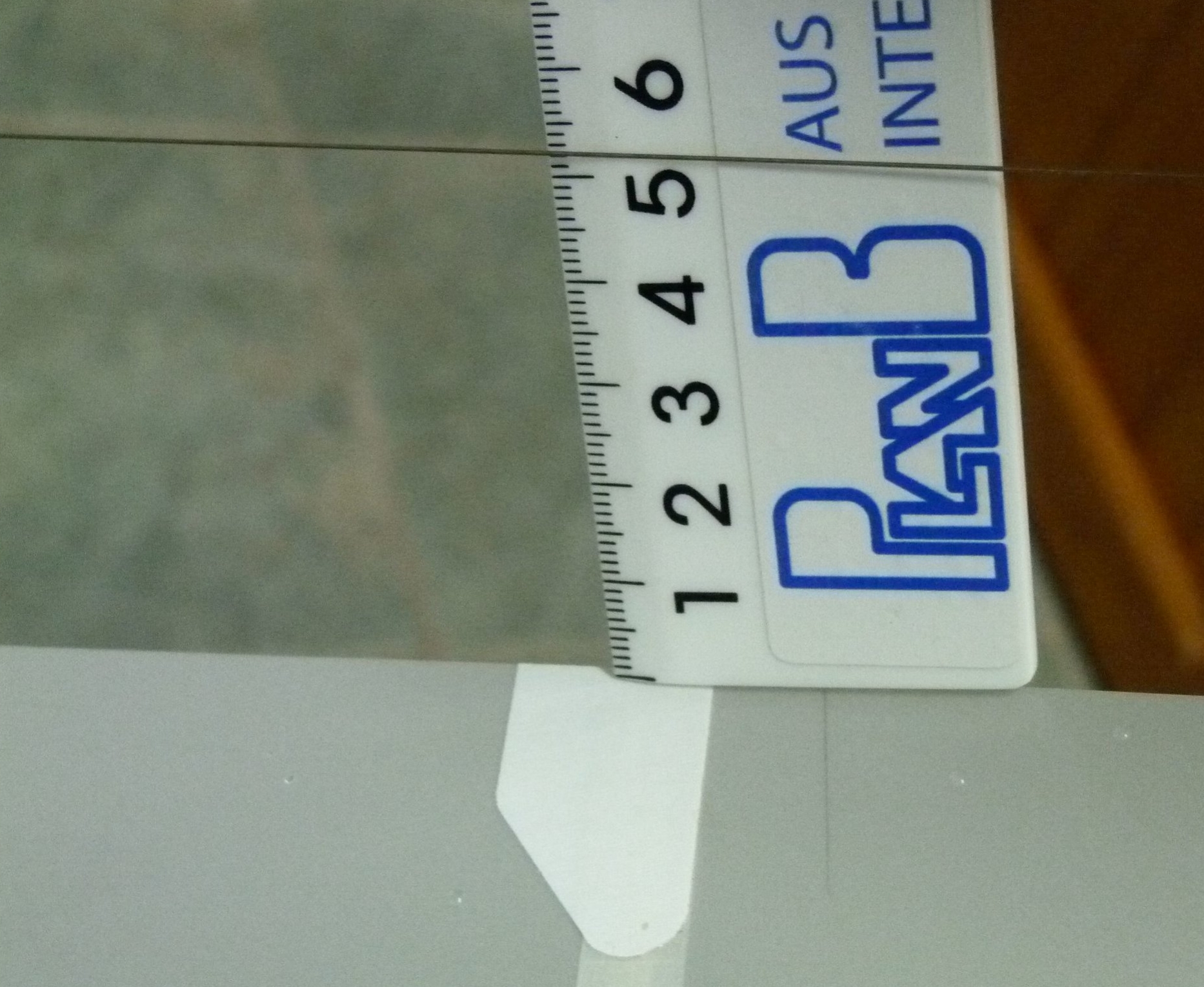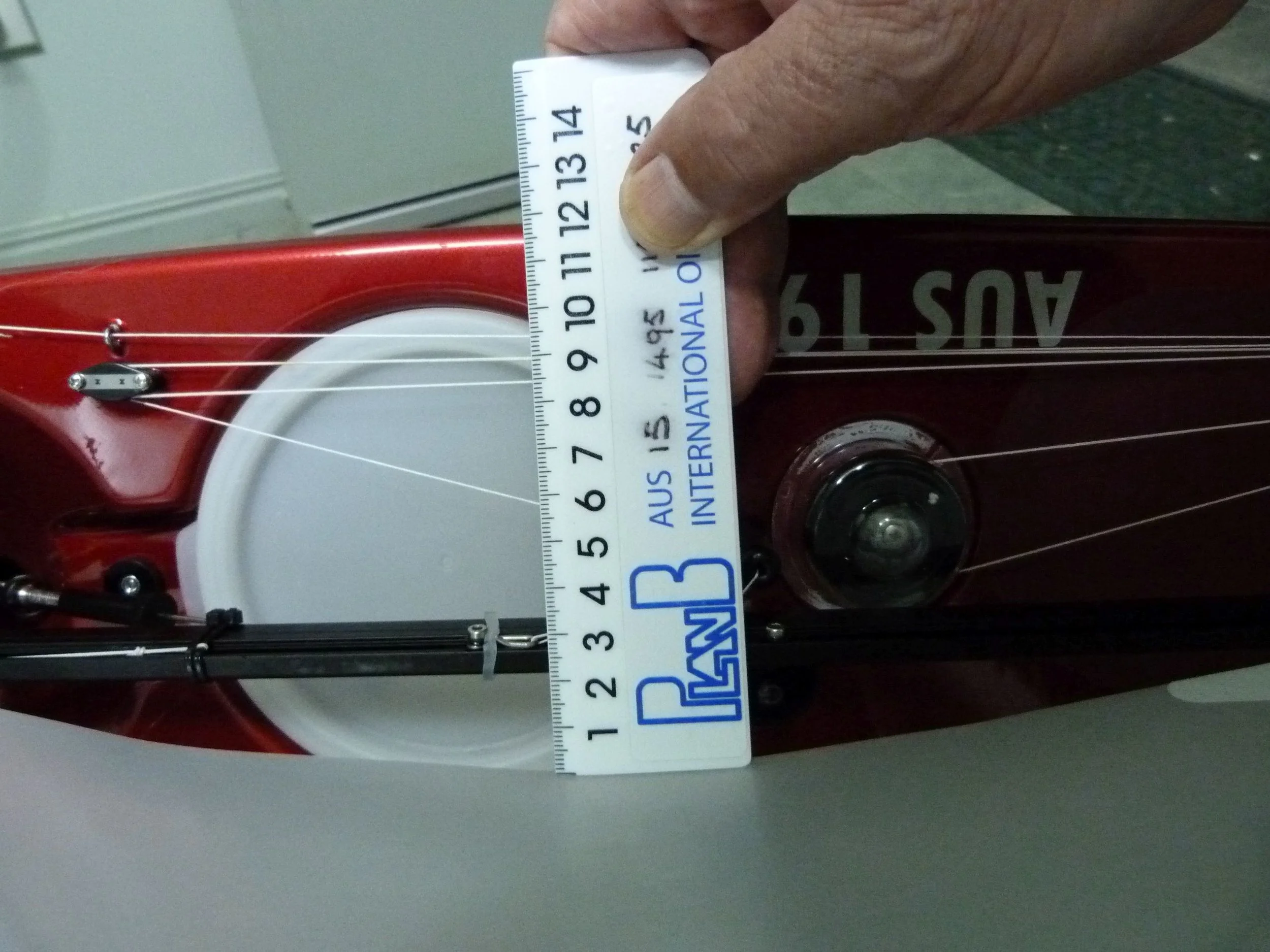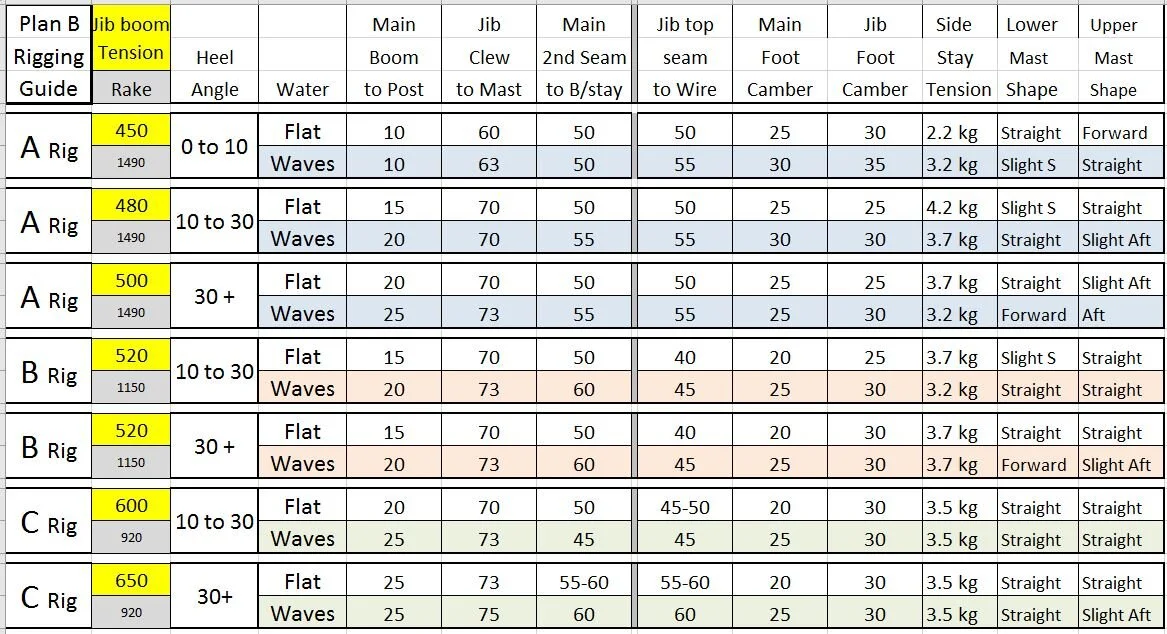Plan B – Step by Step Rigging & Set-Up Guide
Champion sailor, Scott Fleming has prepared this guide to help you gain the best from your Plan B yacht.
Settings have been established firstly from trials and racing during 2018 and are updated as more is learnt.
With Scott's tacit approval, I have added to and tempered some of the notes while leaving his MATRIX untouched.
Rigging and Adjustment
Every time you rig your Plan B, you should do exactly the same steps in order to develop a consistent approach, quickly achieve relocatable settings and develop a greater understanding of an IOM rig dynamics.
Plan B comes with the rigs loose and at the end of the sailing day, you too should loosen off the boom vang, jackstay and down haul to ensure that your main sail is not stored under load. This will help increase the life of your sail.
Your PLAN B comes supplied to rig up perfectly and ready to race following these steps - IN ORDER ...
1. Loosely assemble main, jib, sheets and side stays onto the boat. Tighten side stays to your normal marker (or lock nut). Don’t worry too much about even side stay tension just yet.
2. Backstay Tension should be applied to match the upper main sail luff curve. Keep applying backstay tension slowly and smoothly, whilst watching the top seam of the main, until you see this top seam break its shape ... STOP. Gently release back stay tension until the top seam shape comes back into shape and stop ... Perfect base setting. Tighten main downhaul and jackstay to smooth out any wrinkles in the main.
Here the backstay has been tightened to curve the upper mast back, removing all shape from the mainsail top seam. Not seen readily in this picture is that the even mainsail shape has 'broken' to a ragged form, particularly above the mainsail upper seam.
Now the back stay has been eased to allow the mainsail top seam and upper mainsail to regain the desired shape. In this picture, the mast still has some aft curve from the back stay, flattening the upper mainsail and increasing the fore stay tension which in turn increases the jib boom lift tension at the clew; suited to higher wind strength..
Here the backstay has been further eased to give an almost straight mast, bringing the mainsail close to its constructed fuller shape, with the flow positioned further forward than is shown in the previous picture. The forestay tension and jib boom lift tension at the clew are slightly less and suited to lower wind strength.
Trick Notes:
Light winds – Ease the back stay and apply mast ram. Aim for a straight mast or an even forward bend over the length of the mast to give a fuller main and less jib luff tension. Less jib luff tension gives less jib boom lift tension allowing the jib leech to ease in gusts of a lower wind strength.
Medium Winds – Apply back stay to match main upper luff curve and enough mast ram to straighten lower mast or induce a slight lower rearward S bend.
High Winds – Aim for more aft upper mast bend using the back stay to flatten the upper main sail . Use sufficient mast ram to hold the lower mast straight or with a slight forward bend. Result, greater jib luff tension, greater jib boom lift tension.
Refrain from re-adjusting the back stay to set the final mainsail twist for helm adjustment: use the mast ram. The lower mast can have a slight aft bend, be straight or have a slight forward bend.
Gusty winds and waves - Use back stay tension to bend the upper mast and less ram to keep the mainsail leech free. Less side stay tension for a softer rig with lower jib boom lift tension.
The sail to mast ties should be free to readily set the main sail. The cord will shrink and must be frequently replaced to remain free. Loosely tie 10 kg line with a reef knot around a 2 mm spacer, pull up firmly with pliers and then tie another single knot. Melt the thread ends.
3. Side Stay & Boom Vang Settings: sheet out all the way to the down wind sail setting. Hold the boat by its keel (mast pointing toward the ground) and look down the leech of the main sail, sighting a straight line between the end of the boom to the tip of the mast.
BOOM VANG - Adjust (tighten) your Boom Vang so the top main batten is in line or below your imaginary sighted line between the end of boom and tip of mast. Flip your boom over to check that the leech on other gybe matches perfectly with your initial side (highly unlikely) and your new imaginary sighted line.
When sighted from the clew end of the mainsail boom to the masthead tip, the leech end of the mainsail top seam should be no higher than an imaginary line between these two points.
Trick Notes:
Light and High winds – Aim for the top batten to be approx 30-50mm down from your imaginary line.
Medium Winds - Aim for the top batten to be on or slightly below your imaginary line.
The Boom Vangs sole purpose is to set your downwind main twist setting. - Refrain from setting excessive vang. Twist downwind is fast, particularly in gusty conditions. Once you have the setting you desire, don’t adjust the Boom Vang again. (Many use the boom vang to adjust the upwind sail twist – Do Not do this, use the Mast Ram instead.)
Plan B is quicker down wind with the main boom eased out to 10mm short of the side stay, rather than all the way.
SIDE STAYS - Adjust Side Stay tension to straighten out any sideways mast bend and achieve an even main leech curve on both sides as you flick the boom from side to side. Tighten the opposite side stay to the main leech being lower, if the side stay gets too tight loosen the other side.
Trick Notes:
Before tightening the side stay, use a spare finger to press onto the side stay whilst looking down the main leech to get a feel how much tension needs to be added.
After some practice you will be able to flip the sail from side to side quickly adjusting your boom vang and side stay tensions to be even on both sides, with the correct amount of main sail twist for down wind.
It’s a good idea to have lock nuts on the side stays so your base setting is fairly close and easy to replicate quickly each time ... Although this should be checked each time as a half turn on the side stay turn buckle makes a fair difference.
A & B Rigs generally use the forward side stay deck loops, particularly when the side stays exit from the front of the mast. A & B Rigs can use the rear side stay deck loops when the masts are raked aft to the maximum matrix measurements, or to give greater jib luff tension at the same side stay tension.
The highly raked C Rig uses the back side stay deck loops.
4. Mast Ram Sheet your sails in for your upwind positions (use your MATRIX settings). Adjust your mast ram to suit the upwind main twist and to match your jib twist setting. The ram should be the most frequently adjusted setting on your boat for fine tuning on a race day, with ¼ of a turn making a huge difference. To achieve a correct main leech twist, the ram adjustment might allow a slight forward bend or induce a slight rearward S bend in the lower mast.
During the day you should adjust your mast ram frequently to suit the current wind conditions for each race and for the feel of the helm.
Trick Notes:
More Ram = Less Main Twist – Higher pointing / less speed / more weather helm.
Less Ram = More Main Twist – More speed / less pointing / less weather helm.
5. Sequence Summary
Set the sails clew and boom positions to the MATRIX measurements for the weather of the day.
Adjust the jib leech twist to the MATRIX measurement for the weather of the day.
Adjust the back stay to set the desired mainsail shape.
Adjust the vang to set the mainsail downwind leech twist.
Adjust the ram to set the mainsail upwind leech twist.
Check and if necessary, re-set the jib leech twist.
Test sail and if necessary re-adjust the ram to re-set mainsail upwind leech twist.
OK so the above does look a little daunting ... Once you do this process 5 or 6 times, it will become a habit and easy to remember!
Disclaimer:
Should you not win your races, there is either another Plan B out there (set-up better than yours) OR you haven’t followed the instructions correctly – Try Again!
Plan B – Rigging Guide Notes
All measurements are taken with the boat fully rigged and tensioned ready to race.
Major settings can be made prior to an event with minor adjustments only needing to be made during the course of the day. Setting your Plan B to defined measurements, recording these and the results will enable you to repeat your best performance.
1. Jib Boom Lift Tension determines at what wind pressure the jib and upper mainsail leeches ease. It is measured in gm. from the jib clew with a small digital scale. An accurate measurement is very difficult to achieve, but you will become more consistent with practice. With the boat upright, the measurement is taken as soon as the jib boom starts to lift up. Do this 2-3 times and get a feel for the average. The jib boom lift tension is a product of mast pre-bend, main sail luff curve, back stay tension, jib pivot point location, side stay tension, and mast ram pressure. – in that order of application. The Plan B comes designed and supplied to achieve the tensions shown on the MATRIX. The amount of back stay tension to adjust the mast curve and mainsail shape is determined by the amount of mast pre-bend and the main sail luff allowance curve as these two have been made. More or less backstay tension can be applied to change the mast bend and effective mainsail luff curve and mainsail shape. When the boat is rigged with the sails as desired, the amount of backstay tension will establish the base jib boom lift tension. This lift tension can be increased and tuned by moving the jib boom pivot aft, increasing the side stay tension and increasing the mast ram. The lift tension can be low allowing the jib boom to lift and the jib leech to free early in very light winds but generally we’ve found the more tension the better, so it’s better to be over than under. Figures shown in the MATRIX are considered to be a minimum for medium winds with relatively flat water. In gusty winds and waves we want less tension so the sails leeches ease earlier.
2. After backstay tension, Side Stay Tension is the secondary method of adjusting the critical jib boom lift tension, once having chosen an appropriate jib boom pivot position. Greater side stay tension gives greater jib boom lift tension. It is read in Kg. using a gauge made with pins at 100 mm centres and the digital scale hook at 10 mm from the pins face line. The images below show the side and readout views of the scale. Measurements are taken with the boat upright. A starting guide to achieving the desired A rig, jib boom lift tension is; very light winds, less than 2 Kg. reading on the side stay gauge, light to moderate winds, 2.5 to 3.5 Kg. and heavy winds, up to 4 Kg. In gusty conditions or with waves, the side stay tensions should be less for an overall ‘softer’ rig. A high gauge base setting can be established and lock nuts set prior to race day. The knurled turnbuckle adjustment can be marked with nail-lacquer to readily indicate the amount backed off for a lower than maximum tension. Note, it's neither the gauge reading nor side stay tension in itself that is most important. (The gauge indicates less than half the actual side stay tension.) Mainly they are used for an indication and adjustment of jib boom lift tension. A warning; yachts other than Plan B might not have the construction to accept these side-stay tensions.
3. Mast Rake is measured from the top of the stern deck to the bottom of the top mast band (trailing edge). The Plan B rake is supplied pre-set, but can be adjusted with a small rigging screw or bowsie above the jib head. Generally a tolerance of less rake, up to 5mm longer than the measurements shown in the MATRIX is acceptable, given that measuring is difficult. (particularly single handed with a tape measure) A good idea is to make a stick with measurements marked on it to enable a fast check, however once set, the rake should not change as there are no moving parts to slip. When using A rig maximum rake, the rear side stay deck loops and high side stay tension, the spreaders can be raked back 5 degrees for better mid-mast control.
4. Heel Angle is a guide to the wind strength, so look at the day prior to setting up and try to decide on an average. Generally, rig for the lower end of the days conditions, unless the forecast is for the wind to strengthen. For changing conditions, adjustments to ram, back stay and side stays can be readily and quickly made between races.
5. Main Boom to Post is measured from centreline to centreline. The measurements shown are a guide only, being a good starting point. Adjusting the main boom further in / out will affect weather / lee helm, so some fine tuning and helm feel will be needed and will be slightly different from boat to boat. Try these MATRIX settings first and adjust from there. Wider settings are preferred.
6. Jib Clew to Mast is measured from the jib clew (or jib boom wire / centreline of the jib boom) to the centreline of the mast. Given that the Plan B is designed to run fairly high jib boom lift tensions, this measurement is critical to the boats performance and largely affects the jib /main slot, as little as 3mm makes a vast difference. You’ll find that the Plan B points exceptionally well, running slightly wider jib boom settings helps prevent over pointing and enhances speed.
We’ve found that the following to be a good starting point and easily sighted by eye ...
A Rig - Jib boom straight in a line pointing at the side stay.
B Rig - Jib boom 2-5mm outside of the side stay.
C Rig - Jib boom 5-8mm outside of the side stay.
7. Main 2nd Seam to Backstay is measured from the middle batten to the backstay with the main boom off the post as per your normal upwind sheeted-in position and out of the wind (if possible). Arguably one of the most critical setting for the boats performance, this is impossible to accurately measure outside in the wind. So don’t focus too much on the measurement. The main point to look for ...
When in the breeze and sheeted in (holding and swinging the boat by the keel and looking down the leeches from behind) the main leech should match the jib leech. If anything the main should have slightly more twist.
The Plan B seems to enjoy slightly more twist than other IOM designs and generally has pointing height to burn, so if in doubt, sail with slightly more twist in the main. Remember more twist = more speed.
NOTE: To set/adjust the final upwind main sail twist use only the Mast Ram adjustment. Refrain from altering your boom vang setting to adjust the main sail twist as this will also change the downwind setting. A free downwind leech is fast in all conditions and will minimise tendency to nosedive in strong and gusty winds. In some conditions, setting a free downwind leech and ideal upwind leech with the mast ram might induce a ‘S’ bend to the lower mast. Using the back stay to set/adjust the final upwind main sail twist will also alter the upper sail shape and should be used only when the wind strength changes. With practice, you will set an ideal downwind vang setting together with a suitable back stay setting that will enable an upwind ram setting for main sail leech adjustment, at or only slightly either side of having a straight lower mast.
8. Jib Top Seam to Wire is measured from the top jib seam to the jib boom leech wire, hopefully out of the wind or with the sails not loaded up with breeze.
This is a little easier to measure accurately than the mainsail leech measurement. The aim of running higher jib boom lift tensions is for this jib shape/slot to remain fairly constant, allowing for pointing and sheeting position to be more effective achieving greater height and speed in the gusts. If the jib clew to mast measurement is set greater, this top seam to wire measurement is set smaller, so as to keep the jib leech to mast setting consistent. A high jib boom lift tension delays the leech release and opening of the slot.
9. Main & Jib Foot Camber are both measured by gently pushing a rule against the middle of the sail to the centreline of the boom.
Other Factors for Consideration:
Wind Shifty & Gusty = More twist in both Main and Jib
Flat Water = Less twist and flatter foot camber
Waves = More twist and fuller foot camber
More Wind = Wider sheeting Angles
Light winds = Even forward mast bend for fuller Mainsail and easier Jib boom lift
Rig SETTINGS MATRIX
Scott Fleming
2018
At the lake
With your Plan B tuned, use these logical precepts to win.
Know and be confident of your equipment, settings and technique. RC yacht racing is an acquired skill that needs preparation.
Start the race where your yacht is visible.
Approach the windward mark on starboard tack.
Watch the breeze close behind when running free. Sail to port of the rhumb-line and approach the fleet on starboard gybe near the downwind gate.
Prefer the port side of the downwind gate to place your yacht to starboard of the fleet for the next windward leg.
Watch the breeze well ahead when sailing to windward.
Sail the middle course upwind and again approach the windward mark on starboard tack.
Prefer to duck to avoid any collision-course starboard tack yacht.
Finish at the favoured end of the line.
Know when to disregard any of the above. A fixed strategy cannot successfully be imposed on a fickle sailing race.
Peter
2020






